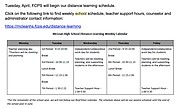Students submitted photos in spirit gear to the staff of Chesterbrook Elementary School to spread love and support. Photo contributed
After a month-long break from in-person schooling, FCPS schools are set to begin distance learning on Tuesday, April 14. Over this break, educators have been working to develop systems that enable all students to participate and learn. Although some teachers have experience guiding online classes, a completely digitized school network is a new experience for all.
The addition of the FCPSON program for high school students ensures all students have a county-issued laptop. A problem, however, arises if students don’t have WiFi at home. History and Social Studies teacher Rachel Baxter of Mclean High School recognizes the importance of teacher-student communication in solving such problems.
“The county worked to ensure that all students have access to WiFi at home. While this is going to close many gaps for our high school students, we must also recognize that it can’t fix all issues of equity. Therefore, teachers will have to approach distance learning with immense flexibility and be sure to support our students however we can.”
DISTANCE LEARNING is not only a major change for students but teachers as well. Stacy Kirkpatrick, a principal at Chesterbrook Elementary School, shares the team effort the school staff undertook to make distance learning possible.
“Teachers received training in multiple tools for distance learning during the week of March 30. While we are teaching in a way that no one ever anticipated, our teachers, aides, and office staff embraced learning new tools that would allow us to engage with our students and bring lessons to them through distance learning. Our staff has worked together, shared ideas, set up practice sessions and spent a lot of time redeveloping curriculum so it would be accessible for our students on April 14.”
Although online school cannot replace the experience of in-person teaching, the addition of the online classes will provide the best-structured remote school day possible. Kirkpatrick comments on the sudden changes caused by the shutdown.
“Across Northern Virginia, we are all so used to a heavily structured school day that may follow with sports, music lessons and homework. On March 13, the structure we all knew was suddenly gone and I hope that distance learning will bring back a sense of normalcy and support that our students are used to.”
THROUGHOUT THIS TRANSITION, there are bound to be obstacles in this unconventional teaching method. Baxter encourages everyone to accept the changes and work to the best of their abilities.
“I hope that everyone keeps in mind that this isn’t normal and that we all approach this with grace. This is new for teachers, and many teachers are now trying to juggle online teaching with all of their responsibilities at home. Students are also struggling and trying to handle a loss of their normal lives for several months. We are all going to do the very best we can, but the most important thing we can focus on right now is the health (both mental and physical) and safety of students.”
Even with all the accommodations put in place by educators, a different level of understanding is anticipated with the curriculum. Kirkpatrick affirms there will be adaptations in the next school year’s educational planning.
“We do anticipate there to be learning loss to a greater degree than a typical summer break. We have a strong system in place to understand where students are performing. When they return in August, we will assess students as we usually do and if there are standards of the curriculum in which they need more support, it will be provided. We will weave in lessons that all students need, provide small group interventions for some and make individual accommodations that may be needed to help students continue to grow academically, socially and emotionally.”


